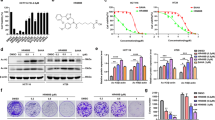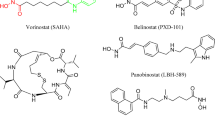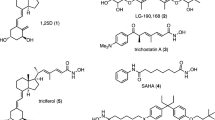Abstract
Histone deacetylases (HDACs) form a family of enzymes, which have fundamental roles in the epigenetic regulation of gene expression and contribute to the growth, differentiation, and apoptosis of cancer cells. In this study, we further investigated the biological function of HDAC5 in cancer cells. We found HDAC5 is associated with actively replicating pericentric heterochromatin during late S phase. We demonstrated that specific depletion of HDAC5 by RNA interference resulted in profound changes in the heterochromatin structure and slowed down ongoing replication forks. This defect in heterochromatin maintenance and assembly are sensed by DNA damage checkpoint pathways, which triggered cancer cells to autophagy and apoptosis, and arrested their growth both in vitro and in vivo. Finally, we also demonstrated that HDAC5 depletion led to enhanced sensitivity of DNA to DNA-damaging agents, suggesting that heterochromatin de-condensation induced by histone HDAC5 silencing may enhance the efficacy of cytotoxic agents that act by targeting DNA in vitro. Together, these results highlighted for the first time an unrecognized link between HDAC5 and the maintenance/assembly of heterochromatin structure, and demonstrated that its specific inhibition might contribute to increase the efficacy of DNA alteration-based cancer therapies in clinic.
Similar content being viewed by others
Log in or create a free account to read this content
Gain free access to this article, as well as selected content from this journal and more on nature.com
or
Change history
11 August 2025
An Editorial Expression of Concern to this paper has been published: https://doi.org/10.1038/s41418-025-01556-x
Abbreviations
- Akt:
-
protein kinase B
- Bax:
-
Bcl-2-associated X
- Bcl-2:
-
B-cell lymphoma 2
- BrdU:
-
5-bromo-2′-deoxyuridine
- CAM:
-
chorioallantoic membrane
- CDK:
-
cyclin-dependent kinase
- CDKi:
-
cyclin-dependent kinase inhibitor
- Chk1:
-
checkpoint kinase 1
- Chk2:
-
checkpoint kinase 2
- Cip1:
-
CDK-interacting protein 1
- CldU:
-
chlorodeoxyuridine
- DMEM:
-
Dulbecco's modified Eagle's medium
- DNMT1:
-
DNA methyltransferase 1
- DSBs:
-
double-strand breaks
- DTT:
-
dithiothreitol
- E2F1:
-
transcription factor E2F1
- FACS:
-
fluorescence-activated cell sorting
- FBS:
-
fetal bovine serum
- FDA:
-
Food and Drug Administration
- FITC:
-
fluorescein isothiocyanate
- γ-H2AX:
-
histone H2A.x phosphorylated on serine 139
- HDAC:
-
histone deacetylase
- HDACi:
-
histone deacetylase inhibitor
- HP-1:
-
heterochromatin protein 1
- HRP:
-
horseradish peroxidase
- HSC70:
-
heat-shock cognate 70-kDa protein
- IdU:
-
iododeoxyuridine
- kip1:
-
kinase-interacting protein 1
- LC3:
-
microtubule-associated protein 1A/1B-light chain 3
- MCM:
-
mini-chromosome maintenance protein
- MEK2:
-
MAPK/ERK kinase 2
- MNaseI:
-
micrococcal nuclease 1
- Mus81:
-
methyl methanesulfonate and ultraviolet-sensitive gene clone 81
- NuRD:
-
nucleosome-remodeling deacetylase complex
- ORC:
-
origin recognition complex
- PBS:
-
phosphate-buffered saline
- PCNA:
-
proliferating cell nuclear antigen
- PI:
-
propidium iodide
- PI3K:
-
phosphoinositide-3-kinase
- pRb:
-
retinoblastoma protein
- RNAi:
-
RNA interference
- SA-β-gal:
-
senescence-associated β-galactosidase
- SAHA:
-
suberoylanilide hydroxamic acid
- SDS:
-
sodium dodecyl sulfate
- siRNA:
-
small interfering RNA
- SIRT:
-
sirtuin
- TSA:
-
trichostatin A
- WST-1:
-
2-(4-iodophenyl)-3-(4-nitrophenyl)-5-(2,4-disulfophenyl)-2H-tetrazolium, monosodium salt
References
de Ruijter AJ, van Gennip AH, Caron HN, Kemp S, van Kuilenburg AB . Histone deacetylases (HDACs): characterization of the classical HDAC family. Biochem J 2003; 370 (Part 3): 737–749.
Bertrand P . Inside HDAC with HDAC inhibitors. Eur J Med Chem (2010); 45: 2095–2116.
Duvic M, Vu J . Vorinostat: a new oral histone deacetylase inhibitor approved for cutaneous T-cell lymphoma. Expert Opin Investig Drugs 2007; 16: 1111–1120.
Mottet D, Pirotte S, Lamour V, Hagedorn M, Javerzat S, Bikfalvi A et al. HDAC4 represses p21(WAF1/Cip1) expression in human cancer cells through a Sp1-dependent, p53-independent mechanism. Oncogene 2009; 28: 243–256.
Wilson AJ, Byun DS, Nasser S, Murray L, Ayyanar K, Arango D et al. HDAC4 promotes growth of colon cancer cells via repression of p21. Mol Biol Cell 2008; 19: 4062–4075.
Zhu C, Chen Q, Xie Z, Ai J, Tong L, Ding J et al. The role of histone deacetylase 7 (HDAC7) in cancer cell proliferation: regulation on c-Myc. J Mol Med 2011; 89: 279–289.
Kitamura Y, Shimizu K, Tanaka S, Ito K, Emi M . Allelotyping of anaplastic thyroid carcinoma: frequent allelic losses on 1q, 9p, 11, 17, 19p, and 22q. Genes Chromosomes Cancer 2000; 27: 244–251.
Scanlan MJ, Welt S, Gordon CM, Chen YT, Gure AO, Stockert E et al. Cancer-related serological recognition of human colon cancer: identification of potential diagnostic and immunotherapeutic targets. Cancer Res 2002; 62: 4041–4047.
Ozdag H, Teschendorff AE, Ahmed AA, Hyland SJ, Blenkiron C, Bobrow L et al. Differential expression of selected histone modifier genes in human solid cancers. BMC Genomics 2006; 7: 90.
Bradbury CA, Khanim FL, Hayden R, Bunce CM, White DA, Drayson MT et al. Histone deacetylases in acute myeloid leukaemia show a distinctive pattern of expression that changes selectively in response to deacetylase inhibitors. Leukemia 2005; 19: 1751–1759.
Osada H, Tatematsu Y, Saito H, Yatabe Y, Mitsudomi T, Takahashi T . Reduced expression of class II histone deacetylase genes is associated with poor prognosis in lung cancer patients. Int J Cancer 2004; 112: 26–32.
Milde T, Oehme I, Korshunov A, Kopp-Schneider A, Remke M, Northcott P et al. HDAC5 and HDAC9 in medulloblastoma: novel markers for risk stratification and role in tumor cell growth. Clin Cancer Res 2010; 16: 3240–3252.
Van Hooser A, Goodrich DW, Allis CD, Brinkley BR, Mancini MA . Histone H3 phosphorylation is required for the initiation, but not maintenance, of mammalian chromosome condensation. J Cell Sci 1998; 111 (Part 23): 3497–3506.
Singer JD, Gurian-West M, Clurman B, Roberts JM . Cullin-3 targets cyclin E for ubiquitination and controls S phase in mammalian cells. Genes Dev 1999; 13: 2375–2387.
Ahn JY, Schwarz JK, Piwnica-Worms H, Canman CE . Threonine 68 phosphorylation by ataxia telangiectasia mutated is required for efficient activation of Chk2 in response to ionizing radiation. Cancer Res 2000; 60: 5934–5936.
Feijoo C, Hall-Jackson C, Wu R, Jenkins D, Leitch J, Gilbert DM et al. Activation of mammalian Chk1 during DNA replication arrest: a role for Chk1 in the intra-S phase checkpoint monitoring replication origin firing. J Cell Biol 2001; 154: 913–923.
Falk M, Lukasova E, Kozubek S . Higher-order chromatin structure in DSB induction, repair and misrepair. Mutat Res 2010; 704: 88–100.
Kim MS, Blake M, Baek JH, Kohlhagen G, Pommier Y, Carrier F . Inhibition of histone deacetylase increases cytotoxicity to anticancer drugs targeting DNA. Cancer Res 2003; 63: 7291–7300.
Ahringer J . NuRD and SIN3 histone deacetylase complexes in development. Trends Genet 2000; 16: 351–356.
Sims JK, Wade PA . Mi-2/NuRD complex function is required for normal S phase progression and assembly of pericentric heterochromatin. Mol Biol Cell 2011; 22: 3094–3102.
David G, Turner GM, Yao Y, Protopopov A, DePinho RA . mSin3-associated protein, mSds3, is essential for pericentric heterochromatin formation and chromosome segregation in mammalian cells. Genes Dev 2003; 17: 2396–2405.
Rountree MR, Bachman KE, Baylin SB . DNMT1 binds HDAC2 and a new co-repressor, DMAP1, to form a complex at replication foci. Nat Genet 2000; 25: 269–277.
Bhaskara S, Chyla BJ, Amann JM, Knutson SK, Cortez D, Sun ZW et al. Deletion of histone deacetylase 3 reveals critical roles in S phase progression and DNA damage control. Mol Cell 2008; 30: 61–72.
Conti C, Leo E, Eichler GS, Sordet O, Martin MM, Fan A et al. Inhibition of histone deacetylase in cancer cells slows down replication forks, activates dormant origins, and induces DNA damage. Cancer Res 2010; 70: 4470–4480.
Bierne H, Tham TN, Batsche E, Dumay A, Leguillou M, Kerneis-Golsteyn S et al. Human BAHD1 promotes heterochromatic gene silencing. Proc Natl Acad Sci USA 2009; 106: 13826–13831.
Heo K, Kim B, Kim K, Choi J, Kim H, Zhan Y et al. Isolation and characterization of proteins associated with histone H3 tails in vivo. J Biol Chem 2007; 282: 15476–15483.
Lemercier C, Brocard MP, Puvion-Dutilleul F, Kao HY, Albagli O, Khochbin S . Class II histone deacetylases are directly recruited by BCL6 transcriptional repressor. J Biol Chem 2002; 277: 22045–22052.
Zhang CL, McKinsey TA, Olson EN . Association of class II histone deacetylases with heterochromatin protein 1: potential role for histone methylation in control of muscle differentiation. Mol Cell Biol 2002; 22: 7302–7312.
Seiler JA, Conti C, Syed A, Aladjem MI, Pommier Y . The intra-S-phase checkpoint affects both DNA replication initiation and elongation: single-cell and -DNA fiber analyses. Mol Cell Biol 2007; 27: 5806–5818.
Willis N, Rhind N . Regulation of DNA replication by the S-phase DNA damage checkpoint. Cell Div 2009; 4: 13.
Lee H, Larner JM, Hamlin JL . A p53-independent damage-sensing mechanism that functions as a checkpoint at the G1/S transition in Chinese hamster ovary cells. Proc Natl Acad Sci USA 1997; 94: 526–531.
Mathew R, Kongara S, Beaudoin B, Karp CM, Bray K, Degenhardt K et al. Autophagy suppresses tumor progression by limiting chromosomal instability. Genes Dev 2007; 21: 1367–1381.
McPherson JP, Lemmers B, Chahwan R, Pamidi A, Migon E, Matysiak-Zablocki E et al. Involvement of mammalian Mus81 in genome integrity and tumor suppression. Science 2004; 304: 1822–1826.
Marchion DC, Bicaku E, Turner JG, Schmitt ML, Morelli DR, Munster PN . HDAC2 regulates chromatin plasticity and enhances DNA vulnerability. Mol Cancer Ther 2009; 8: 794–801.
Marchion DC, Bicaku E, Daud AI, Sullivan DM, Munster PN . Valproic acid alters chromatin structure by regulation of chromatin modulation proteins. Cancer Res 2005; 65: 3815–3822.
Waltregny D, Glenisson W, Tran SL, North BJ, Verdin E, Colige A et al. Histone deacetylase HDAC8 associates with smooth muscle alpha-actin and is essential for smooth muscle cell contractility. FASEB J 2005; 19: 966–968.
Vandelaer M, Thiry M . The phosphoprotein pp135 is an essential constituent of the fibrillar components of nucleoli and of coiled bodies. Histochem Cell Biol 1998; 110: 169–177.
Mendez J, Stillman B . Chromatin association of human origin recognition complex, cdc6, and minichromosome maintenance proteins during the cell cycle: assembly of prereplication complexes in late mitosis. Mol Cell Biol 2000; 20: 8602–8612.
Labarca C, Paigen K . A simple, rapid, and sensitive DNA assay procedure. Anal Biochem 1980; 102: 344–352.
Rampakakis E, Di Paola D, Zannis-Hadjopoulos M . Ku is involved in cell growth, DNA replication and G1–S transition. J Cell Sci 2008; 121 (Part 5): 590–600.
Acknowledgements
This work was supported by grants from the National Fund for Scientific Research (FNRS) (Belgium), the Centre Anti-Cancéreux près de l’Université de Liège, the Fonds Léon Frédéricq, and TELEVIE. D Mottet and F Dequiedt are Research Associates at the National Fund for Scientific Research (FNRS). M Boxus is Postdoctoral Researcher at the FNRS. N Matheus is an FRIA Fellow. A Gonzalez is TELEVIE Fellow. We thank Dr D DiPaola for expert advice on the nascent-strand DNA abundance assay.
Author information
Authors and Affiliations
Corresponding author
Ethics declarations
Competing interests
The authors declare no conflict of interest.
Additional information
Edited by H Ichijo
Supplementary Information accompanies the paper on Cell Death and Differentiation website
Supplementary information
Rights and permissions
About this article
Cite this article
Peixoto, P., Castronovo, V., Matheus, N. et al. HDAC5 is required for maintenance of pericentric heterochromatin, and controls cell-cycle progression and survival of human cancer cells. Cell Death Differ 19, 1239–1252 (2012). https://doi.org/10.1038/cdd.2012.3
Received:
Revised:
Accepted:
Published:
Issue date:
DOI: https://doi.org/10.1038/cdd.2012.3
Keywords
This article is cited by
-
Human colon cancer cells highly express myoferlin to maintain a fit mitochondrial network and escape p53-driven apoptosis
Oncogenesis (2019)
-
Investigation into the Molecular Mechanisms underlying the Anti-proliferative and Anti-tumorigenesis activities of Diosmetin against HCT-116 Human Colorectal Cancer
Scientific Reports (2019)
-
A novel long noncoding RNA HOXC-AS3 mediates tumorigenesis of gastric cancer by binding to YBX1
Genome Biology (2018)
-
Myoferlin controls mitochondrial structure and activity in pancreatic ductal adenocarcinoma, and affects tumor aggressiveness
Oncogene (2018)
-
Metabolic inhibitors accentuate the anti-tumoral effect of HDAC5 inhibition
Oncogene (2017)



